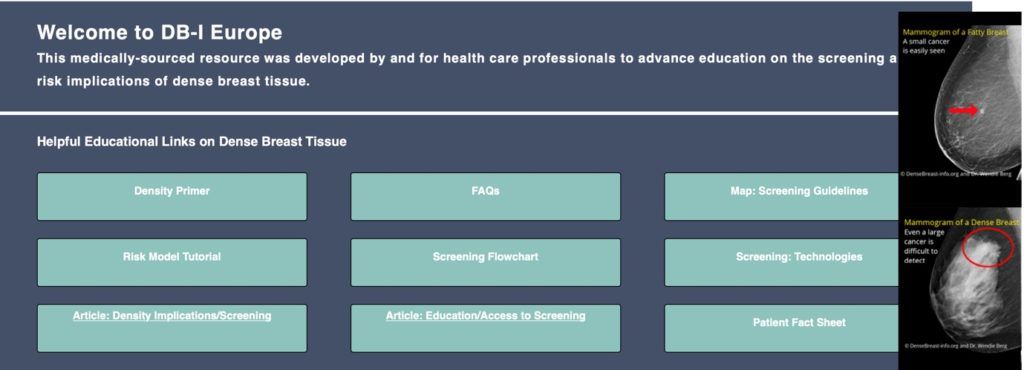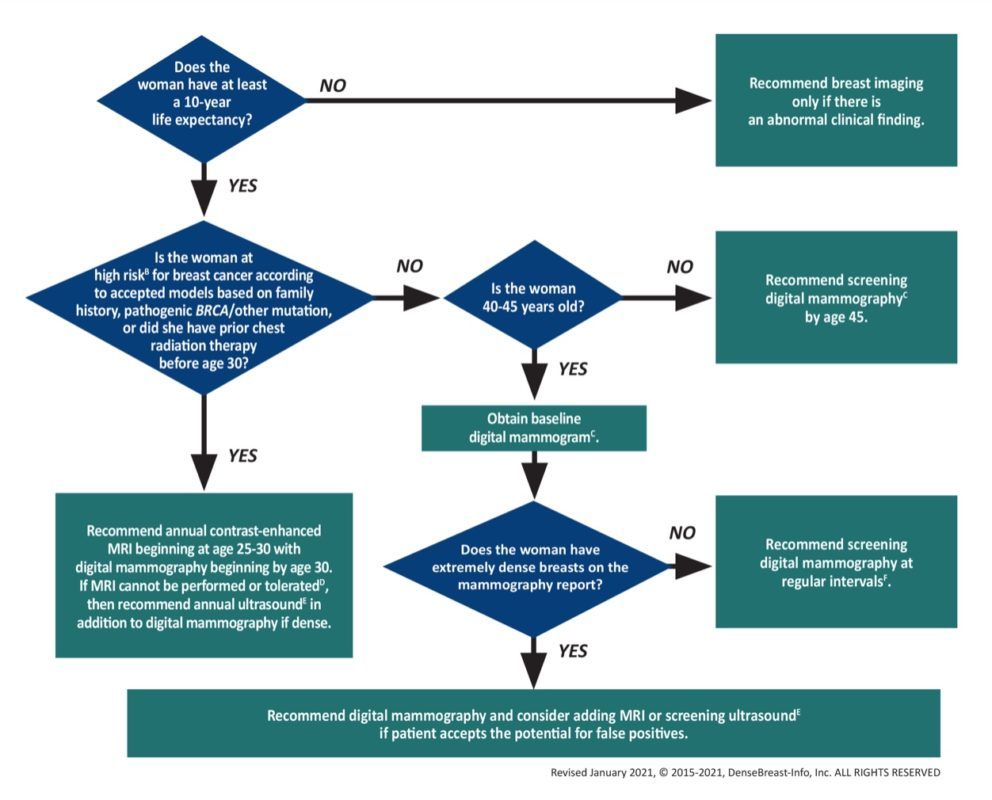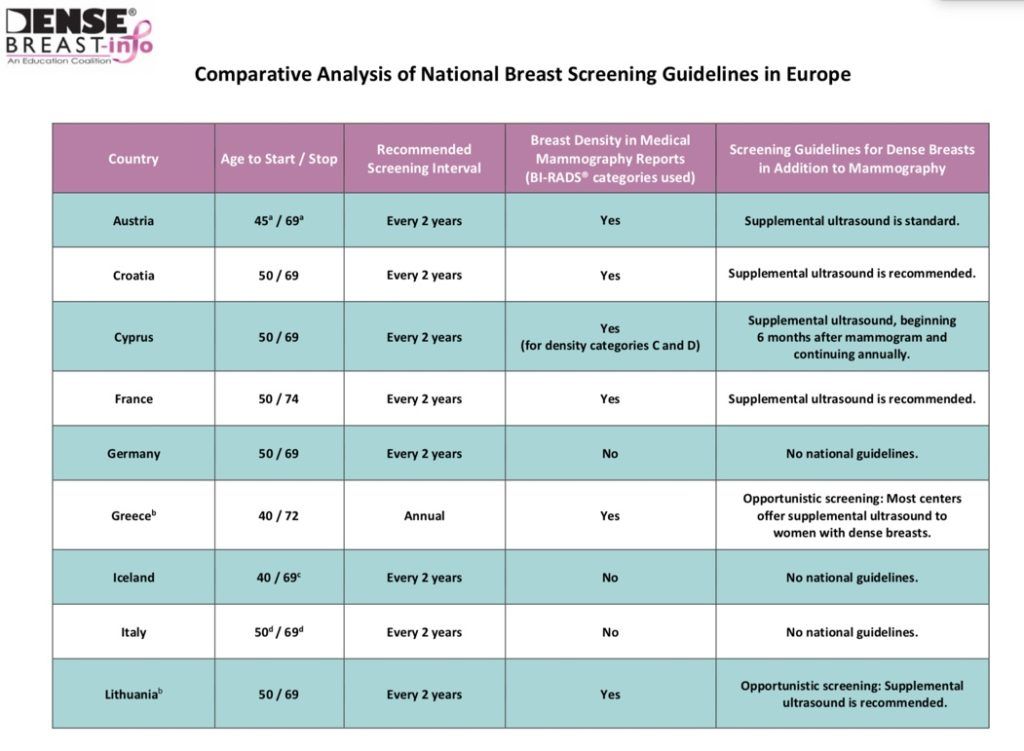DBI European site
The European Breast Density Educational Coalition
The one-size-fits-all screening randomized controlled trials with mammography have proven a 25-30% reduction in the mortality rate of breast cancer, which is attributed to earlier detection of the disease leading to improved women’s outcome [1,2,3]. Despite that, breast cancer remains the most common cancer among women in Europe with more than 523,000 newly diagnosed cancers each year [4]. Meanwhile, it has been documented that the performance of screening with mammography varies among women and this depends on the type of breast composition. Multiple studies have demonstrated that increased breast density impairs the sensitivity of mammography due to masking effect of non-calcified carcinomas; that accounts for a large proportion of missed cancers and false negative mammograms in screening programs [5-8]. Some of these cancers appear as interval cancers (diagnosed due to symptoms after a negative screen) which are highly associated with larger tumor size and positive lymph nodes at time of diagnosis. Boyd et al. [9] showed an 18-fold increased likelihood of interval cancer in women with extremely dense breasts compared to women with fatty breasts while Kerlikowske et al. [10] demonstrated a higher advanced-stage interval cancer rate in women with extremely or heterogeneously dense breasts. Additionally, breast density has been identified as the most frequent risk factor in both premenopausal and postmenopausal women.
Despite the recognized evidence of supplemental screening in women with dense breasts there is a lack of consistent guidelines among European countries.
In order to provide access to breast density educational tools, DenseBreast-info.org (DB-I), was originally established in the USA and has been recognized as the most up-to-date comprehensive, medically resourced website for online breast density information.
Aiming to expand its influence to meet the needs of European Health Providers, the DB-I/Europe was launched in 2018 jointly with the publication of a review article at European Radiology, entitled Breast Density Implications and Supplemental Screening authored by Drs. Athina Vourtsis and Wendie Berg. The launch and publication received US and international media coverage, including features in ecancer news, Pink Ribbon online newsletter and Radiology Business.
DB-I/Europe, a medically-sourced website, is the collaborative effort of European breast imaging experts. Athina Vourtsis, MD, PhD, Director and Founder of Diagnostic Mammography Center, Athens, Greece serves as the organization’s European Liaison, and Cheryl Cruwys, a career educator who is instrumental in breast density education in the United Kingdom supports this effort as European education coordinator.

DB-I/Europe content includes details on screening and communication standards about breast density for 16 European countries. Our mission is to provide educational resources to European healthcare providers about the screening and risk implications of dense breast tissue and value of supplemental screening with expanded content and tools and to inform women on this important topic.

This educational tool is supported by availability of our CME opportunity, Breast Density: Why it Matters through the European Accreditation Council for CME. Furthermore, we continue our efforts to meet the needs of European health providers with expanded content which include:
- Dense Breast Primer for Health care providers
- Table: Comparative Analysis of National Breast Screening Guidelines in Europe

copyright, © DenseBreast-info.org
- A comprehensive content of FAQs with literature citations
- Explanation of breast screening technologies
- Risk Model Tutorial (includes details on how the models are used, risk model explanations, diagnostic considerations, and a risk model table)
- An easy-to-follow screening flowchart
- Patient Fact Sheet (one-page, downloadable; available in multiple languages), aiming to inform women about breast density implications and to pursue discussions with their imaging experts about their screening options.
- Diagnostic Imaging/Europe article: Using Education to Overcome Unequal Access to Supplemental Screening for Women with Dense Breasts
We are delighted DB-I/Europe has become a reliable resource for health care providers, researchers and patients. We have seen a 25 percent year over year increase in website users and we are pleased that health professionals; European universities and medical professional organizations in Europe are taking advantage of this resource. We are continuing our effort in engaging Ambassadors from additional European countries which would further increase the widespread utilization of this resource.
References:
1. Berry DA, Cronin KA, Plevritis SK, Fryback DG, Clarke L, Zelen M, Mandelblatt JS, Yakovlev AY, Habbema JD, Feuer EJ, Cancer I, Surveillance Modeling Network C. Effect of screening and adjuvant therapy on mortality from breast cancer. N Engl J Med. 2005;353: 1784-92.
2. Tabar L, Vitak B, Chen TH, Yen AM, Cohen A, Tot T, Chiu SY, Chen SL, Fann JC, Rosell J, Fohlin H, Smith RA, Duffy SW. Swedish two-county trial: impact of mammographic screening on breast cancer mortality during 3 decades. Radiology. 2011;260: 658-63.
3. Coldman A, Phillips N, Wilson C, Decker K, Chiarelli AM, Brisson J, Zhang B, Payne J, Doyle G, Ahmad R. Pan-Canadian study of mammography screening and mortality from breast cancer. J Natl Cancer Inst. 2014;106.
4. Ferlay J, Colombet M, Soerjomataram I, et al. Cancer incidence and mortal- ity patterns in Europe: Estimates for 40 countries and 25 major cancers in 2018. Eur J Cancer 2018; 103: 356-387.
5. Nelson HD, O’Meara ES, Kerlikowske K, Balch S, Miglioretti D. Factors Associated With Rates of False-Positive and False-Negative Results From Digital Mammography Screening: An Analysis of Registry Data. Ann Intern Med. 2016;164: 226-35.
6. Yankaskas BC, Cleveland RJ, Schell MJ, Kozar R. Association of recall rates with sensitivity and positive predictive values of screening mammography. AJR Am J Roentgenol. 2001;177: 543-9.
7. Posso M, Louro J, Sanchez M, Roman M, Vidal C, Sala M, Bare M, Castells X, group Bs. Mammographic breast density: How it affects performance indicators in screening programmes? Eur J Radiol. 2019;110: 81-7.
8. Vourtsis A & Berg WA. Breast density implications and supplemental screening. Eur radiol. 2019; 29(4): 1762-1777. doi: 10.1007/s00330- 018-5668-8
9. Boyd NF, Guo H, Martin LJ, Sun L, Stone J, Fishell E, Jong RA, Hislop G, Chiarelli A, Minkin S, Yaffe MJ. Mammographic density and the risk and detection of breast cancer. N Engl J Med. 2007;356: 227-36.
10. Kerlikowske K, Zhu W, Tosteson AN, Sprague BL, Tice JA, Lehman CD, Miglioretti DL, Breast Cancer Surveillance C. Identifying women with dense breasts at high risk for interval cancer: a cohort study. Ann Intern Med. 2015;162: 673-81.
